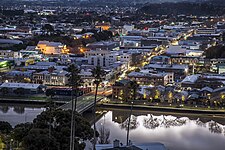Whanganui
Whanganui | |
|---|---|
 | |
| Nickname: The River City | |
| Motto(s): Sans Dieu Rien, English:Without God Nothing[1] | |
| Coordinates:39°55′57″S175°03′07″E/ 39.93250°S 175.05194°E | |
| Country | New Zealand |
| Region | Manawatū-Whanganui |
| Territorial authority | Whanganui District Council |
| Government | |
| • Mayor | Andrew Tripe |
| • Deputy Mayor | Helen Craig |
| Area | |
| • Territorial | 2,373.26 km2(916.32 sq mi) |
| • Urban | 41.05 km2(15.85 sq mi) |
| Population (June 2024)[3] | |
| • Territorial | 48,600 |
| • Density | 20/km2(53/sq mi) |
| •Urban | 42,500 |
| • Urban density | 1,000/km2(2,700/sq mi) |
| Postcode(s) | 4500, 4501 |
| Area code | 06 |
| Website | Whanganui.govt.nz |
Whanganui(/ˈhwɒŋənuːi/;[4]Māori:[ˀwaŋanui]), also speltWanganui,[5]is acityin theManawatū-Whanganuiregion ofNew Zealand.The city is located on the west coast of theNorth Islandat the mouth of theWhanganui River,New Zealand's longest navigable waterway. Whanganui is the19th most-populous urban area in New Zealandand the second-most-populous in Manawatū-Whanganui, with a population of 42,500 as of June 2024.[3]
Whanganui is the ancestral home of Te Āti Haunui-a-Pāpārangi and otherWhanganui Māoritribes. TheNew Zealand Companybegan to settle the area in 1840, establishing its second settlement afterWellington.In the early years, most European settlers came via Wellington. Whanganui greatly expanded in the 1870s, andfreezing works,woollen mills, phosphate works and wool stores were established in the town. Today, much of Whanganui's economy relates directly to the fertile and prosperous farminghinterland.
Like several New Zealand urban areas, it was officially designated acityuntil an administrative reorganisation in 1989, and is now run byWhanganui District Council.
Toponymy
[edit]Whanga nuiis aMāori languagephrase meaning "big bay" or "big harbour". The first name of the European settlement wasPetre(pronounced Peter), after Lord Petre, an officer of theNew Zealand Company,but it was never popular and was officially changed to "Wanganui" in 1854.[6]
Controversy over Wanganui/Whanganui spelling
[edit]In the local dialect,Māoripronounce thewhinWhanganuias[ˀw],avoiced labial–velar approximantcombined with aglottal stop,[7]but to non-locals the name sounds like "Wanganui" and is hard to reproduce.
In 1991, theNew Zealand Geographic Boardconsidered demands from some local Māori to change the name of the river toWhanganui.[8]During a three-month consultation period, the Wanganui District Council was asked for its views and advised the Board that it opposed the change. Letters of both support and opposition were received during this time. After some deliberation, the Board decided to change the spelling of the river's name from "Wanganui" to "Whanganui".[9][10]
A non-bindingreferendumwas held in Wanganui in 2006, where 82% voted to retain the city's name "Wanganui" without an 'h'. Turnout was 55.4%.[11]Despite the clear results, the spelling of the name continued to be surrounded by significant controversy.[12][13]
Iwigroup Te Rūnanga o Tupoho applied to the New Zealand Geographic Board to change the city's name to "Whanganui" in February 2009, and in late March the Board found there were grounds for the change.[14]The public was given three months to comment on the proposed change, beginning in mid-May.[15]The public submissions were relatively equal, with a slim majority in favour of keeping the status quo.[16]Wanganui Mayor Michael Laws spoke strongly against the proposed change.[11]A second referendum was held in Wanganui in May 2009, and residents again overwhelmingly rejected changing the city's name, with 22% voting to change it to "Whanganui" and 77% voting to retain the name as "Wanganui".[17][18]Voter turnout was 61%, the highest in a Wanganui referendum, reflecting the widespread controversy.[18]Recognising that the decision was ultimately political in nature, not linguistic, in September 2009 the Geographic Board handed the decision to the Minister for Land Information.[19]Despite the referendum results, the Geographic Board recommended to the Minister that the name should be spelt "Whanganui".[20][16]In December 2009, the government decided that while either spelling was acceptable,Crown agencieswould use the spelling "Whanganui",[21]amending the act to allow other official documents to use "Wanganui", as an alternative official name, if desired.[22]
On 17 November 2015Land Information New ZealandToitū te whenua(LINZ) announced that Wanganui District would be renamed to Whanganui District.[23]This changed the official name of the District Council, and, because Whanganui is not a city council but a district, the official name of the urban area as well. On 19 November 2015, the name change was officially gazetted.[24]In September 2019, theregionthat Whanganui District Council is part of was renamed from Manawatu-Wanganui to Manawatū-Whanganui.[25]
History
[edit]Māori settlement
[edit]
The area around the mouth of the Whanganui river was a major site of pre-EuropeanMāorisettlement. Thepānamed Pūtiki (a contraction ofPūtikiwharanui) was and is home to theNgāti Tupohohapūof theiwiTe Āti Haunui-a-Pāpārangi.[26]It took its name from the legendary explorerTamatea Pōkai Whenua,who sent a servant ashore to find flax for tying up his topknot (pūtiki).[27]
In the 1820s, coastal tribes in the area assaulted theKapiti Islandstronghold ofNgāti ToachiefTe Rauparaha.Te Rauparaha retaliated in 1830, sacking Pūtiki and slaughtering the inhabitants.[28]
European settlement
[edit]The first European traders arrived in 1831, followed in 1840 by missionariesOctavius HadfieldandHenry Williamswho collected signatures for theTreaty of Waitangi.[28]On 20 June 1840, the Revd John Mason, Mrs Mason, Mr Richard Matthews (a lay catechist) and his wife Johanna arrived to establish a mission station of theChurch Missionary Society(CMS).[29]The RevdRichard Taylorjoined the CMS mission station in 1843.[30]The Revd Mason drowned on 5 January 1843 while crossing the Turakina River.[30][31]By 1844 the brick church built by Mason was inadequate to meet the needs of the congregation, and it had been damaged in an earthquake. A new church was built under the supervision of Taylor, with the timber supplied by each pā on the river in proportion to its size and number of Christians.[32]

After theNew Zealand Companyhad settledWellingtonit looked for other suitable places for settlers. William Wakefield, younger brother ofEdward Gibbon Wakefield,negotiated the sale of 40,000 acres in 1840, and a town named Petre – afterLord Petre,one of the directors of the New Zealand Company – was established four kilometres from the river mouth.[28]The settlement was threatened in 1846 byTe Mamaku,a chief from up the Whanganui River. The British military arrived on 13 December 1846 to defend the township. Two stockades, the Rutland and York, were built to defend the settlers. Two minor battles were fought on 19 May and 19 July 1847 and after a stalemate the up river iwi returned home.[33]By 1850, Te Mamaku was receiving Christian instruction from Revd Taylor.[33]There were further incidents in 1847 when four members of the Gilfillan family were murdered and their house plundered.[34]
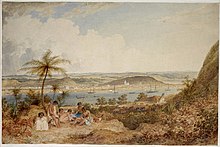
The name of the city was officially changed to Wanganui on 20 January 1854. The early years of the new city were problematic. Purchase of land from the local tribes had been haphazard and irregular, and as such, many Māori were angered by the influx ofPākehāonto land that they still claimed. It was not until the town had been established for eight years that agreements were finally reached between the colonials and local tribes, and some resentment continued (and still filters through to the present day).
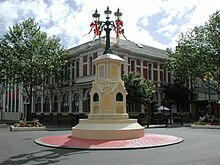
Wanganui grew rapidly after this time, with land being cleared for pasture. The town was a major military centre during theNew Zealand Warsof the 1860s, although local Māori at Pūtiki led byTe Keepa Te Rangihiwinuiremained friendly to settlers. In 1871, a town bridge was built,[35]followed six years later by a railway bridge at Aramoho.[28]Wanganui was linked by rail to bothNew PlymouthandWellingtonby 1886. The town was incorporated as aBoroughon 1 February 1872, withWilliam Hogg Wattthe first Mayor. It was then declared a city on 1 July 1924.[28]
Wanganui Women's Political League
[edit]As an alternative to the Wanganui chapter of theWomen's Christian Temperance Union of New Zealand,Margaret Bullockformed a club for women activists in 1893, originally as the Wanganui Women's Franchise League.Ellen Ballance,the second wife of the former PremierJohn Ballancewas the inaugural president until she left for England. Bullock then served as president whenthe franchise for womenwas won and the organisation's name changed to the Women's Political League. The membership rolls reached to nearly 3000 at its height. Monthly meetings focused on feminist scholarly inquiry, and Ellen Ballance donated her husband's library to the club. Bullock andJessie Williamsonled the club's connections with theNational Council of Women of New Zealand.By 1903, a year in which Bullock died and Williamson moved toChristchurch,the club's activities had declined and its library collection was donated to the local public library.[36]
20th century
[edit]Perhaps Wanganui's biggest scandal happened in 1920, when MayorCharles Mackayshot and wounded a young poet,Walter D'Arcy Cresswell,who had been blackmailing him over his homosexuality. Mackay served seven years in prison and his name was erased from the town's civic monuments, while Cresswell (himself homosexual) was praised as a "wholesome-minded young man".[37]Mackay's name was restored to the foundation stone of theSarjeant Galleryin 1985.[38]
TheWhanganui Rivercatchment is seen as a sacred area to Māori, and the Whanganui region is still seen as a focal point for any resentment over land ownership. In 1995,Moutoa Gardensin Wanganui, known to local Māori asPakaitore,were occupied for 79 days in a mainly peaceful protest by the Whanganui iwi over land claims.
Wanganui was the site of theNew Zealand PoliceLaw Enforcement System(LES) from 1976 to 1995. An earlySperrymainframe computer-based intelligence and data management system, it was known colloquially as the "Wanganui Computer". The data centre housing it was subject to New Zealand's highest-profilesuicide bombingon 18 November 1982 when anarchistNeil Robertsdetonated agelignitebomb in the entry foyer. Roberts was the only casualty of the bombing.
Geography
[edit]Whanganui is on theSouth Taranaki Bight,close to the mouth of theWhanganui River.It is 200 km (120 mi) north ofWellingtonand 75 km (47 mi) northwest ofPalmerston North,at the junction ofState Highways3 and 4. Most of the city lies on the river's northwestern bank, because of the greater extent of flat land. The river is crossed by five bridges: Cobham Bridge, City Bridge, Dublin Street Bridge and Aramoho Railway Bridge (rail and pedestrians only) and a Cycle bridge which was opened in 2020.[39]
BothMount RuapehuandMount Taranakican be seen from Durie Hill and other vantage points around the city.
Suburbs and localities
[edit]The suburbs within Whanganui include (clockwise from central Watt Fountain):
- Northeast:Whanganui East,Bastia Hill,Aramoho[40]
- East:Durie Hill
- South:Pūtiki[41]
- West:Gonville,Castlecliff,Tawhero
- Northwest:SpringvaleSt Johns Hill,Otamatea
Climate
[edit]Whanganui enjoys a temperate climate, with slightly above the national average sunshine (2100 hours per annum), and about 900 mm (35 in) of annual rainfall. Several light frosts are normally experienced in winter. The river is prone to flooding after heavy rain in the catchment, and in June 2015 record flooding occurred with 100 households evacuated. Whanganui's climate is particularly moderate. In 2012, the Federated Farmers Whanganui president, Brian Doughty, said the district's temperate climate meant any type of farming was viable.[42]
| Climate data for Whanganui (1991–2020) | |||||||||||||
|---|---|---|---|---|---|---|---|---|---|---|---|---|---|
| Month | Jan | Feb | Mar | Apr | May | Jun | Jul | Aug | Sep | Oct | Nov | Dec | Year |
| Mean daily maximum °C (°F) | 22.6 (72.7) |
23.0 (73.4) |
21.6 (70.9) |
19.1 (66.4) |
16.7 (62.1) |
14.3 (57.7) |
13.6 (56.5) |
14.3 (57.7) |
15.8 (60.4) |
17.1 (62.8) |
18.7 (65.7) |
21.0 (69.8) |
18.2 (64.8) |
| Daily mean °C (°F) | 18.3 (64.9) |
18.6 (65.5) |
17.1 (62.8) |
14.9 (58.8) |
12.8 (55.0) |
10.6 (51.1) |
9.7 (49.5) |
10.4 (50.7) |
11.9 (53.4) |
13.4 (56.1) |
14.8 (58.6) |
17.0 (62.6) |
14.1 (57.4) |
| Mean daily minimum °C (°F) | 14.1 (57.4) |
14.1 (57.4) |
12.7 (54.9) |
10.6 (51.1) |
8.8 (47.8) |
6.8 (44.2) |
5.8 (42.4) |
6.6 (43.9) |
8.1 (46.6) |
9.6 (49.3) |
10.9 (51.6) |
13.0 (55.4) |
10.1 (50.2) |
| Average rainfall mm (inches) | 58.1 (2.29) |
69.6 (2.74) |
60.5 (2.38) |
84.5 (3.33) |
80.8 (3.18) |
90.3 (3.56) |
87.0 (3.43) |
83.5 (3.29) |
75.9 (2.99) |
89.1 (3.51) |
75.3 (2.96) |
89.5 (3.52) |
944.1 (37.18) |
| Average rainy days(≥ 1.0 mm) | 6.3 | 6.4 | 7.6 | 8.9 | 10.0 | 11.6 | 11.3 | 12.1 | 10.5 | 10.5 | 9.2 | 9.6 | 114 |
| Averagerelative humidity(%) | 72.8 | 77.3 | 78.6 | 79.5 | 82.2 | 83.7 | 84.0 | 81.5 | 75.3 | 75.7 | 72.2 | 72.2 | 77.9 |
| Mean monthlysunshine hours | 250.2 | 213.5 | 192.1 | 159.4 | 129.0 | 99.2 | 120.7 | 137.8 | 147.5 | 180.5 | 203.6 | 221.9 | 2,055 |
| Source: NIWA Climate Data (sun 1981–2010)[43][44] | |||||||||||||
Demographics
[edit]The Whanganui urban area had a population of 39,720 at the2018 New Zealand census,an increase of 3,078 people (8.4%) since the2013 census,and an increase of 1,992 people (5.3%) since the2006 census(the population decreased between the 2006 and 2013 censuses). There were 18,930 males and 20,793 females, giving a sex ratio of 0.91 males per female. Of the total population, 7,854 people (19.8%) were aged up to 15 years, 6,867 (17.3%) were 15 to 29, 16,551 (41.7%) were 30 to 64, and 8,445 (21.3%) were 65 or older.[45]
Ethnicities were 78.0% European/Pākehā, 27.2% Māori, 3.8% Pacific peoples, 4.5% Asian, and 1.7% other ethnicities (totals add to more than 100% since people could identify with multiple ethnicities).[45]
| SA2 name | Population | Dwellings | Median age | Median income |
|---|---|---|---|---|
| Balgownie | 120 | 69 | 47.5 years | $23,100 |
| Bastia-Durie Hill | 2,130 | 990 | 46.4 years | $33,100 |
| Castlecliff East | 1,917 | 714 | 33.1 years | $21,800 |
| Castlecliff West | 1,593 | 705 | 40.8 years | $22,400 |
| College Estate | 1,284 | 507 | 39.3 years | $23,100 |
| Cornmarket | 1,350 | 798 | 49.4 years | $21,700 |
| Gonville North | 2,565 | 1,113 | 33.8 years | $24,000 |
| Gonville South | 2,004 | 843 | 38.9 years | $24,200 |
| Gonville West | 1,707 | 696 | 37.7 years | $19,900 |
| Laird Park | 2,247 | 1,020 | 38.8 years | $22,000 |
| Lower Aramoho | 1,869 | 786 | 36.6 years | $22,000 |
| Otamatea | 1,731 | 735 | 55.6 years | $29,900 |
| Putiki | 666 | 285 | 49.9 years | $31,100 |
| Springvale East | 1,452 | 657 | 45.6 years | $27,300 |
| Springvale North | 348 | 150 | 53.2 years | $27,300 |
| Springvale West | 1,572 | 702 | 46.7 years | $27,600 |
| St Johns Hill East | 1,173 | 492 | 60.1 years | $24,400 |
| St Johns Hill West | 2,202 | 969 | 49.6 years | $29,400 |
| Titoki | 2,943 | 1,182 | 39.0 years | $22,200 |
| Upper Aramoho | 2,097 | 918 | 41.6 years | $24,200 |
| Wembley Park | 1,695 | 708 | 38.5 years | $22,200 |
| Whanganui Central | 606 | 318 | 39.5 years | $26,000 |
| Whanganui East-Riverlands | 2,184 | 1,023 | 42.8 years | $24,300 |
| Whanganui East-Williams Domain | 2,277 | 996 | 42.8 years | $23,300 |
Economy
[edit]In 2013, 2014, 2015 and 2016, Whanganui was included in the world's Smart21 Intelligent Communities by the Intelligent Community Forum.[47]
Whanganui has a strong industry base, with a history of niche manufacturing. Current businesses include Q-West Boat Builders, based at the Port who have built boats for customers from around New Zealand and the world and were awarded a contract in 2015 to build two 34-meter passenger ferries for Auckland ferry company Fullers.[48][49][50][51]Pacific Helmets is another example of award-winning niche manufacturing in the district, winning a Silver Pin at the Best Design Awards in October 2015.[52]Heads Road is Whanganui's main industrial area and is home to a number of manufacturing and engineering operations. The Wanganui Port, once the centre of industrial transport, still has some traffic but is more noted for the Q-West boat building operation there.F. Whitlock & Sons Ltdwas a notable company, first established in 1902.[53]
Much of Whanganui's economy relates directly to the fertile and prosperous farming hinterland near the town. Whanganui is well known for embracing the production of several new pear varieties, including the Crimson Gem.[54]In May 2016, it was reported that the majority of the Whanganui pear crop had been wiped out before the upcoming pear season.[55]
Whanganui District
[edit]The Whanganui District covers 2,337 km2(902 sq mi), the majority of which is hill country, with a narrow coastal strip of flat land and a major urban settlement on the lower banks of the Whanganui River. A large proportion of this is within theWhanganui National Park,established in 1986.
The region is known for its outstanding natural environment, with the Whanganui Awa (River) at its heart. It is the second-largest river in the North Island, the longest navigable waterway in the country, and runs for 290 km (180 mi) from the heights of Mount Tongariro to Wanganui's coast and the Tasman Sea. Every bend and rapid of the river (there are 239 listed rapids) has a guardian, or kaitiaki, who maintains the mauri (life force) of that stretch of the river.
Whanganui hapū (sub-tribes) were renowned for their canoeing skills and maintained extensive networks of weirs and fishing traps along the River. Generations of river iwi have learned to use and protect this great taonga (treasure), and on 13 September 2012 theWhanganui River became the first river in the world to gain recognition as a legal identity.[56]
Today the river and its surrounds are used for a number of recreational activities, including kayaking, jet boating, tramping, cycling and camping. A national cycleway has recently opened, which takes cyclists from the 'mountains to the sea'.
In the local government reorganisation of the 1980s, Wanganui District Council resulted from the amalgamation in 1989 of Wanganui County Council, most of Waitotara County Council, a small part of Stratford County Council, and Wanganui City Council. Hamish McDouall was elected mayor in the 2016 local government elections.[57]
All but some 6,100 people in the Whanganui District live in the township itself, meaning there are few prominent outlying settlements. A small but notable village isJerusalem,which was home to MotherMary Joseph Aubertand the poetJames K. Baxter.
The Whanganui District is also home to other settlements with small populations, including Kaitoke,Upokongaro,Kai Iwi/Mowhanau, Aberfeldy, Westmere,Pākaraka,Marybank,Okoiaand Fordell.
Culture
[edit]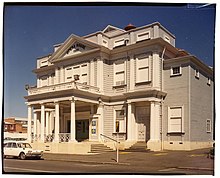
Cultural institutions
[edit]Whanganui has a strong cultural and recreational focus. Queen's Park (Pukenamu) in the central township has several cultural institutions, including theSarjeant Gallery,theWhanganui Regional Museum,the Davis Library, the Alexander Heritage and Research Library, and the Whanganui War Memorial Centre. Whanganui is home to New Zealand's only glass school and is renowned for its glass art.
Sarjeant Gallery collection
[edit]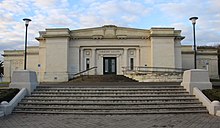
There are more than 8,000 artworks[58]in the gallery, initially focused on 19th- and early 20th-century British and European art but, given the expansive terms of the will of benefactorHenry Sarjeant,the collection now spans the 16th century through to the 21st century. Among the collections are historic and modern works in all media – on paper, sculptures, pottery, ceramics and glass; bronze works; video art; and paintings by contemporary artists and old masters. The Gallery holds notable works byEdward Coley Burne-Jones,Domenico Piola,Frank Brangwyn,Bernardino Poccetti,Gaspard Dughet,William Richmond,William Etty,Lelio Orsi,Frederick Goodall,Augustus Johnand others. Its New Zealand holdings include six works by Wanganui artistHerbert Ivan Babbageand a major collection of works by the Whanganui-bornEdith Collier.[59]
Whanganui Regional Museum collection
[edit]TheWhanganui Regional Museumcollection has been growing since the first items were displayed inSamuel Henry Drew's shop window in Victoria Avenue. It includes artwork byJohn Tiffin Stewart.
Potters
[edit]Potters have a long history of working in the area, such asRick Rudd,Paul Raynerand Ivan Vostinar.[60][61]
Glass artists
[edit]Local glass artists include Kathryn Wightman,[62]Lisa Walsh,[63]and Claudia Borella.[64]
Theatre
[edit]Arepertorygroup has been active in the town since 1933.[citation needed]
Opera
[edit]Since 1994, The New Zealand Opera School has been hosted atWhanganui Collegiate School.[65][66]
Landmarks and buildings
[edit]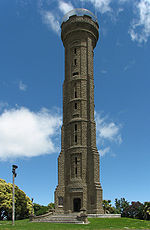
Pukenamu–Queens Park in central Whanganui, formerly the hilltop location of the Rutland Stockade, is home to several iconic buildings. TheSarjeant Gallery,a Category I Historic Place,[67]was a bequest to the town by local farmerHenry Sarjeant,and opened in 1919. Since 2014, it has been in temporary premises on Taupo Quay while the heritage building is strengthened and redeveloped. TheWhanganui Regional Museum(1928) and theAlexander Heritage and Research Library(1933) were both bequests of the Alexander family. The award-winningWhanganui War Memorial Hall(1960) is one of New Zealand's finest examples of modernist architecture.[68]
TheRoyal Whanganui Opera Houseis located in St Hill Street in central Whanganui.
Stewart House on the corner of Campbell and Plymouth Streets is now a private home, but it was formerly theKaritaneHome and later a boarding residence for secondary school students. It was built for philanthropistJohn Tiffin Stewartand social activistFrances Ann Stewart.
There are two large towers overlooking Whanganui: theDurie Hill War Memorial Towerand the Bastia Hill Water Tower. The Durie Hill Tower is a World War I memorial, unveiled in 1926. Nearby is theDurie Hill Elevator(1919), which links the hilltop with Anzac Parade via a 66 m (217 ft) elevator and a 200 m (660 ft) tunnel. South of Whanganui is theCameron Blockhouse.

Rotokawau Virginia Lake,located on St John's Hill, is a historic lake with a fountain, Art Deco conservatory and winter garden.[69]
Local attractions
[edit]Bason Botanic Gardens
[edit]These gardens are located 8 km (5.0 mi) northwest from Whanganui and are set on 25 ha (62 acres) in a relatively frost-free environment.[70][71]They were founded in 1966 by Stanley and Blanche Bason[72]who gave their farm to the city council for the purpose of creating a botanical reserve.[73]The gardens have six themed areas, including one of the most extensive public-garden orchid collections in the country, and have been rated as a Garden of Significance by theNew Zealand Gardens Trust.[70]
Bushy Park Tarapuruhi
[edit]Bushy Park is a lowlandrainforestremnant of approximately 100 ha (250 acres) located 8 km (5.0 mi) fromKai Iwi,north of Whanganui.[74]It is a predator-free nativebird sanctuary.[75][76]The sanctuary is free to visit during daylight hours.[77]The park also features an Edwardian-erahomestead,which is a Category 1 heritage building registered withHeritage New Zealand.[78]
Social and religious history
[edit]Early institutions
[edit]- Karitane Hospital
- Wanganui Orphanage
- Alma Gardens
People, early recorders of social history
[edit]- Richard Taylorwas one of the early missionaries and travelled widely through the region.
- William Tyrone Power[79]
- Edward Jerningham Wakefield
Contemporary institutions
[edit]- TheSociety of St Pius X's main base of operations in New Zealand is in Whanganui.
Sports
[edit]
| |||||||
Rugby
[edit]TheWanganui Rugby Football Unionis one of the oldestrugbyunions in New Zealand.
Wanganui has never held the country's top trophy, theRanfurly Shield.
On 10 August 1966, a combined Wanganui and King Country team beat theBritish and Irish Lions12 points to 6 at Spriggens Park.
In 2008, the Wanganui representative rugby team, under the captaincy of David Gower, won the NZRFU's Heartland Championship (Meads Cup) by defeating Mid Canterbury 27–12 in the final. They had previously been the defeated finalist in 2006 and 2007. The 2008 side had an undefeated season – the first since 1947. The rugby squad, including coach and management, was accorded the honour of 'Freedom of the City' by the Whanganui District Council – the first time the award had been given to any sporting team.
The 2009 representative team repeated this feat by regaining the Meads Cup – again defeating Mid Canterbury in the final by 34 points to 13 (after trailing nil-13 at halftime). Unlike 2008, the 2009 did lose games (to Wellington, Wairarapa Bush and Mid Canterbury) but came good at the business end of the season. Ten Whanganui players were selected for the Heartland XV.
The Wanganui rugby jersey, due to its resemblance, is known as the butcher's apron.[81]
The Whanganui environs have produced manyAll Blacksincluding:
- Moke Belliss(1920–23).
- John Blair(1897).
- George Bullock-Douglas(1932–34).
- Andrew Donald(1981–84).
- Keith Gudsell(1949). He also played three tests for theWallabies.
- Andy Haden(1972–85).
- Peter Henderson(1949–50).
- John Hogan(1907). He also played for New Zealand at rugby league (1913) and was a national waterpolo champion.
- Peter Arthur Johns (1968).
- Peter McDonnell(1896).
- Alasdair "Sandy" McNicol(1973).
- Henare "Buff" Milner(1970).
- Peter Murray(1908).
- Bill Osborne(1975–82).
- Glen Osborne(1995–99).
- Waate "Pat" Potaka(1923).
- Harrison Rowley(1949).
- Peina Taituha also known as Taituha Peina Kingi (1923).
- Hector "Mona" Thomson(1905–08).
Although from the Manawatu, 1987 Rugby World Cup winning All Black CaptainDavid Kirkwas a student atWanganui Collegiate School.
Athletics
[edit]Whanganui has several high-quality sporting venues includingCooks Gardens,a major sporting venue used for cricket, athletics and rugby. On 27 January 1962, a world record time of 3 minutes 54.4 seconds for running themilewas set byPeter Snellon the grass track at the gardens. The venue also has a world-class velodrome.
Motor-racing
[edit]TheCemetery Circuitis a temporary motorcycle street racetrack in downtown Whanganui which passes through the old cemetery and industrial area near to the centre of town. The event is usually held on Boxing Day each year.
Rod Colemanwas a Grand Prix motorcycle road racer.[82]
Earl Bamberwas a racing driver and winner of the2015 24 Hours of Le Mansand2014 Porsche Supercup.
Horse racing
[edit]The Wanganui Jockey Club operates at the Wanganui Racecourse, Purnell Street, where it has been since 1848, said to be the oldest racing club In New Zealand still operating on its original land.[83]
Important races held include the:
- Ag Challenge Stakes.
- H S Dyke Wanganui Guineas.
- Fillies Series.
- Wanganui Cup.
New Zealand Racing Hall of FameandAustralian Racing Hall of FamejockeyBrent Thomsonwas born and started his career in Wanganui.[84]
The Wanganui Trotting Club now holds meetings at the Palmerston North track.
Infrastructure
[edit]Transport
[edit]Whanganui Airportis served byAir Chathamswith flights toAuckland.[85][86]
Horizons Regional Council, under their Go! brand, contracts ten weekday urban bus routes within the city and a Saturday route which combines parts of four of the routes to serve the northern part of the city. From 18 February 2023 a 'frequent' (20-minute interval, except Sunday) bus links Castlecliff and Aramoho, though most routes are 2-hourly.[87]The regional council also runs commuter buses to Palmerston North, and monthly buses fromTaihape.The services are all operated byTranzit Group.[88]Go cards were replaced byBee Cardsin December 2019.[89]
Whanganui hadtramsbetween Aramoho and Castlecliff from 1908 to 1950, when they were replaced by Greyhound buses.[90]Greyhound was taken over by Tranzit in 1995.[91]
The township was also served bythree stationsand apassenger rail trainrunning toNew Plymouthuntil this was cancelled in July 1977. Today the line is used for freight.
Energy
[edit]The Wanganui-Rangitikei Electric Power Board was established in 1921 to supply the city and surrounding areas with electricity. The city was connected toMangahao hydroelectric schemeon 23 April 1926, following the completion of the transmission line fromBunnythorpeto Whanganui and the Whanganui substation.[92]The Energy Companies Act 1992 saw the power board corporatise and merge with the New Plymouth Municipal Electricity Department and the Taranaki Electric Power Board to becomePowerco.Powerco sold its retail base toGenesis Energyas part of the 1998 electricity sector reforms and continued as an electricity distribution business.[93][94]
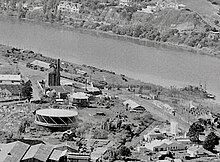
Whanganui was one of the original nine towns and cities in New Zealand to be supplied withnatural gaswhen theKapuni gas fieldentered production in 1970 and a 260 km high-pressure pipeline from Kapuni to Wellington via the city was completed. The high-pressure transmission pipelines supplying the city are now owned and operated byFirst Gas,with GasNet owning and operating the medium and low-pressure distribution pipelines within the city.[95]
Whanganui was first supplied with pipedgasin March 1879.[96]Coal was shipped from Greymouth, or Westport.[97]
Water
[edit]Whanganui had a mains water supply from Rotokawau Virginia Lake from 1876.[98]From 1904 water was piped from the upper Okehu valley.[99]In 1933 springs at Kai Iwi were used to supplement the supply.[100]Water now comes fromartesianbores at Kai Iwi and Aramoho.[101]
Education
[edit]- Whanganui Collegiate Schoolis in Liverpool Street, central Whanganui. It was founded by a land grant in 1852 by theGovernor of New Zealand,Sir George Grey,to theBishop of New Zealand,George Augustus Selwyn,for the purpose of establishing a school. It was originally a boys-only school, but in 1991 began admitting girls at senior levels and went fully co-educational in 1999. The school celebrated its 150th anniversary in 2004. The school amalgamated with St George's School in 2010. The combined schools provide primary education for day students on the St George campus, and secondary education for day and boarding students on the Collegiate campus.[102]Prince Edward, Earl of Wessex,spent two terms spanning 1982 and 1983 at the school as a junior master during hisgap year.
- Whanganui City Collegeis located in Ingestre Street, central Whanganui, and has had three names. Wanganui Technical College, established in 1911, became Wanganui Boys' College in 1964 and in 1994 it became Wanganui City College.[103]
- Whanganui High Schoolis in Purnell Street.
- Whanganui Girls' Collegeis in Jones Street, Whanganui East, near the Dublin Street Bridge.
- Cullinane Collegeis an integrated, co-educational college in Peat Street, Aramoho.
- St. Dominic'sCollege is in York Street, Gonville.
- Te Kura Kaupapa Māori o Te Atihaunui-A-Paparangi is in Anaua Street, Putiki.
- Te Kura o Kokohuia is in Matipo Street, Castlecliff.
- Te Kura Kaupapa Māori o Tupoho is in Cross Street, Castlecliff.
- UCOL, Universal College of Learning, was founded in 1907 and was known as thePalmerston NorthTechnical School. In 1971 it became the Palmerston North Technical Institute and in 1983 theManawatuPolytechnic. At the time it specialised in trade apprenticeship courses, and in hobby, art, and craft classes, along with a range of night school programmes inbusiness studiesfor working adults. UCOL expanded in January 2001 with the incorporation of theWairarapaRegional Polytechnic and the integration of the Whanganui Regional Community Polytechnic on 1 April 2002.
- The Wanganui Regional Community Polytechnic is now called Whanganui UCOL and incorporates theWanganui School of Design.
Media
[edit]Whanganui has three local newspapers. Whanganui was the first town in the wider Wellington region to have its own newspaper, theWanganui Record,which was first published in 1853.[104]TheWhanganui Chronicle,founded in 1856, is New Zealand's oldest newspaper, and has been a daily paper since 1871. Its rival from the 1860s onward was theEvening Herald(later theWanganui Herald), founded byJohn Ballance.Initially, the production of theWanganui Chroniclewas held back by a lack of equipment, meaning the first issue, dated 18 September 1856, was produced on a makeshift press, made by staff and pupils at the local industrial school.[104]Shortly afterwards, the founder, Henry Stokes, imported a press from Sydney. The two daily papers joined in the 1970s, and in 1986 theHeraldbecame a free weekly, later renamed theWanganui Midweek.[104]TheRiver City Pressis the other free weekly paper.
Whanganui isserved by 25 radio stations:22 on FM and three on AM. In 1996, Whanganui briefly rose to international infamy when a man who claimed to be carrying a bomb held local radio station Star FM (nowMore FMWhanganui) hostage and demanded that the station broadcastThe Muppetssong "The Rainbow Connection"for 12 hours.[105]
Television coverage reached Whanganui in 1963, after theWharite Peaktransmitter near Palmerston North was commissioned to relay Wellington's WNTV1 channel.[106]Due to terrain blocking the Wharite signal to parts of the city, coverage was supplemented by a translator at Mount Jowett inAramoho.Today, digital terrestrial television (Freeview) is available in the city from both Wharite and Mount Jowett.[107][108]
Notable people
[edit]- Israel Adesanya(born 1989), mixed martial artist
- Sister Mary Joseph Aubert(1835–1926), founder of Our Lady of Compassion atJerusalem
- Harriet Austin(born 1988), rower who rowed 200 miles across the Mediterranean[109]
- Ellen Ballance(1846–1935), suffragist and community worker
- John Ballance(1839–1893), politician and businessman
- Earl Bamber,racing driver
- Airini Beautrais,poet
- Annie Maude Blackett,librarian
- Ruka Broughton(1940–1986),tohunga,Anglican priest and university lecturer
- John Bryce,politician
- Brit Bunkley,artist
- Paul Callaghan,physicist
- Edith Collier,artist
- Nathan Dahlberg,racing cyclist and team manager
- Johnny Devlin,musician
- Samuel Henry Drew,jeweller and founder of the Whanganui Regional Museum
- Dave Feickert,international mines safety advisor
- Henry Augustus Field,surveyor
- Janet Gillies,nurse
- Peter Gordon,International chef and restaurant owner
- Michael Laws,former mayor
- Douglas Lilburn,composer
- Te Mamaku,Māori chief
- Pura McGregor,community leader
- Robert Martin,disability rights activist
- Jerry Mateparae,former Chief of the New Zealand Defence Force and Governor General of New Zealand
- Christodoulos Moisa,poet, writer, and art teacher
- Peter Nicholls,sculptor
- Anne Noble,photographer
- Ray O'Leary,comedian
- Simon Owen,professional golfer, the 1976 International Double Diamond individual golf champion and winner of 17 tournaments around the world[84]
- Brian Perkins,broadcaster and musician
- Victoria Ransom,software entrepreneur
- Paul Rayner,artist
- Iriaka Rātana,first woman to represent Māori in New Zealand parliament
- Herbert Reeve,Vicar of Wanganui 1911 to 1924
- Helen Rockel,painter
- Henry Sarjeant,farmer and benefactor of theSarjeant Art Gallery
- Tim Seifert,cricketer
- Maxwell James Grant Smart,farmer, museum director, historian, archaeologist and writer
- Frances Ann Stewart,social activist
- John Tiffin Stewart,engineer, artist and philanthropist
- Brian Talboys,politician
- Richard Taylor,early missionary at Putiki
- James Allen Ward,Victoria Cross recipient
- Emily White,gardener and writer
- Jane Winstone,aviator
Sister cities
[edit]Whanganui has twosister cities,as designated bySister Cities International:
- Toowoomba,Queensland,Australia since 1983
- Nagaizumi,Shizuoka,Japan[110]since 1988
The Wanganui District Council decided in 2008 to formally end its sister city relationship withReno,Nevada,USA after years of inactivity.[111]The relationship was parodied on "The Prefect of Wanganui" episode ofReno 911!.
Image gallery
[edit]- Whanganui
-
Glasgow Street Dairy
-
Whanganui River mouth, boat and swimmers
-
Surfer at Castlecliff Beach
-
Beach, Whanganui
-
Waimarie paddle steamer and rowers on the Whanganui River
-
Fishers at South Mole
-
Whanganui Musicians Club at the Old Savage Club
-
Along the river road
-
Upriver nearJerusalem(Hiruharama)
-
River scene
-
Hydroplanes on the river
-
Fragile river
-
Rowers on the river
-
TheRoyal Wanganui Opera Housein 2013
-
From Durie Hill at night
References
[edit]- ^https://www.whanganui.govt.nz/Your-Council/About-Whanganui-District-Council/Our-History#section-2Whanganui District Council, 'Our Coat of Arms'
- ^"ArcGIS Web Application".statsnz.maps.arcgis.com.Retrieved25 April2024.
- ^ab"Aotearoa Data Explorer".Statistics New Zealand.Retrieved26 October2024.
- ^"Residents free to choose city's spelling".TVNZ.Retrieved19 January2015.
- ^"Notice of the Determination of the Minister for Land Information on Assigning Alternative Geographic Names".Land Information New Zealand. 13 December 2012.Retrieved16 March2013.
- ^"Whanganui in 1841".New Zealand History.Ministry for Culture and Heritage.Archivedfrom the original on 29 October 2020.Retrieved29 October2020.
- ^Bauer, Winifred (2010)."The Wanganui/Whanganui Debate: A Linguist's View Of Correctness"(PDF).Victoria University of Wellington. pp. 11–12.Archived(PDF)from the original on 20 July 2020.Retrieved21 July2020.
- ^"Moutoa Gardens protest".Archivedfrom the original on 29 October 2020.Retrieved29 October2020.
- ^"How we say 'Whanganui'".Archivedfrom the original on 29 October 2020.Retrieved29 October2020.
- ^"Frequently Asked Questions about the Minister's Decision".Archivedfrom the original on 29 October 2020.Retrieved29 October2020.
- ^abBurns, Kelly (4 April 2009)."Wanganui spelling change slammed".Stuff.Archivedfrom the original on 29 October 2020.Retrieved19 January2015.
- ^"Board to decide Wanganui spelling".Otago Daily Times.Allied Press. 25 March 2009.Archivedfrom the original on 29 October 2020.Retrieved29 October2020.
- ^"Michael Laws condemns 'petty vandals' for adding h to Wanganui".Newshub.MediaWorks TV. 3 March 2009.Archivedfrom the original on 29 October 2020.Retrieved29 October2020.
- ^New Zealand Geographic Board to publicly consult on ‘h’ in Wanganui.30 March 2009.Archived25 September 2009 at theWayback Machine
- ^Whanganui.Archived23 September 2009 at theWayback Machine
- ^ab"Whanganui decision 'great day for city' – Turia".The New Zealand Herald.17 September 2009.Archivedfrom the original on 21 October 2012.Retrieved17 September2009.
- ^"Results of Referendum 09".21 May 2009. Archived fromthe originalon 25 May 2010.Retrieved22 May2009.
- ^abEmerson, Anne-Marie."Wanganui says: No H".Wanganui Chronicle.NZME Publishing.Archivedfrom the original on 29 October 2020.Retrieved29 October2020.
- ^Bauer, Winifred (2010)."The Wanganui/Whanganui Debate: A Linguist's View Of Correctness"(PDF).Victoria University of Wellington. p. 17.
- ^"Wanganui proposed change to Whanganui".Land Information New Zealand.Archivedfrom the original on 29 October 2020.Retrieved29 October2020.
- ^"Whanganui or Wanganui – it's up to you".The New Zealand Herald.18 December 2009.
- ^"Whanganui or Wanganui – it's up to you".NZ Herald.Retrieved30 November2021.
- ^"'H' to be added to Wanganui District name ".Land Information New Zealand (LINZ).17 November 2015.Retrieved2 February2016.
- ^"Notice of the Final Determination of the Minister for Land Information on a Local Authority District Name".Archivedfrom the original on 15 October 2021.Retrieved15 October2021.
- ^"Seal of approval for spelling of Manawatū-Whanganui region".RNZ.2 January 2020.Archivedfrom the original on 23 September 2019.
- ^"Pūtiki Pā".Māori Maps.Retrieved3 December2015.
- ^Young, David (24 August 2015)."Whanganui tribes".Te Ara – the Encyclopedia of New Zealand.Retrieved3 December2015.
- ^abcdeWises New Zealand Guide, 7th Edition, 1979. p. 494.
- ^"Pre 1839 Settlers in New Zealand".
- ^abRogers, Lawrence M. (1973).Te Wiremu: A Biography of Henry Williams.Pegasus Press.
- ^"The Church Missionary Gleaner, July 1843".Progress of the Gospel in the Western District of New Zealand – the death of Rev J Mason.Adam Matthew Digital.Retrieved12 October2015.
- ^"The Church Missionary Gleaner, June 1845".Erection of Places of Worship in New Zealand.Adam Matthew Digital.Retrieved13 October2015.
- ^ab"The Church Missionary Gleaner, December 1850".The Chief Mamaku.Adam Matthew Digital.Retrieved17 October2015.
- ^"The Church Missionary Gleaner, January 1854".The Murderer Rangiirihau.Adam Matthew Digital.Retrieved18 October2015.
- ^"THE GOVERNOR'S VISIT TO WANGANUI. NEW ZEALAND MAIL".paperspast.natlib.govt.nz.9 December 1871.Retrieved5 September2020.
- ^Labrum, Bronwyn (1993). "Wanganui Women's Political League 1893-c.1902". In Else, Anne (ed.).Women Together: A History of Women's Organisations in New Zealand.Wellington, NZ: Historical Branch, Dept. of Internal Affairs; Daphne Brasell Assoc. Press. pp. 77–78.
- ^"Charles Mackay and D'Arcy Cresswell".Retrieved10 October2007.
- ^"Wanganui mayor shoots poet".Retrieved17 April2011.
- ^"Cycle bridge opens in time for summer".www.whanganui.govt.nz.Retrieved12 July2022.
- ^"About the profile areas – Lower Aramoho".profile.id.11 April 2017.Retrieved1 June2019.
- ^"Iwi – Whanganui Iwi / Te Atihaunui a Pāpārangi – Te Kahui Mangai".TKM.14 February 2019.Archivedfrom the original on 14 February 2019.Retrieved1 June2019.
- ^van Delden, Aaron (18 April 2012)."A great climate for growth".Wanganui Chronicle.Retrieved17 January2020.
- ^"Climate data and activities".NIWA. Archived fromthe originalon 20 May 2024.Retrieved20 May2024.
- ^"Climate Data".NIWA.Retrieved2 November2007.
- ^ab"Age and sex by ethnic group (grouped total response), for census usually resident population counts, 2006, 2013, and 2018 Censuses (urban rural areas)".nzdotstat.stats.govt.nz.Retrieved13 September2020.
- ^"2018 Census place summaries | Stats NZ".www.stats.govt.nz.Retrieved14 December2020.
- ^"The Smart21 Communities".Intelligent Community Forum.Retrieved1 April2015.
- ^Maslin."Boat Building Business Booms".Wanganui Chronicle.Retrieved1 April2015.
- ^"Building better boats".Crown Fibre Holdings.Retrieved1 April2015.
- ^Maslin, John."Pride of Wanganui heads to open water for first sea trial".No. 12 September 2014. APN. New Zealand Herald.Retrieved1 April2015.
- ^"At the Helm – Q-West's success story".m.nzherald.co.nz.Retrieved15 November2015.
- ^"Helmet designed in Wanganui wins elite award".m.nzherald.co.nz.Retrieved15 November2015.
- ^"Death of Mr F. Whitlock".Wanganui Chronicle.Vol. L, no. 12145. 24 August 1908. p. 5.Retrieved12 January2014.
- ^"New pear varieties going down a treat".The New Zealand Herald.Retrieved11 April2019.
- ^Stowell, Laurel (18 May 2016)."Disease ends orchard and jobs".Wanganui Chronicle.Retrieved17 January2020– via New Zealand Herald.
- ^"Innovative bill protects Whanganui River with legal personhood".www.parliament.nz.28 March 2017.Retrieved3 September2022.
- ^"ELECTION RESULTS – WHANGANUI".Wanganui Chronicle. 8 October 2016.Retrieved9 October2016.
- ^Martin, Robin (23 June 2016)."Art gallery has one week to find $3.3m".RNZ.Retrieved24 September2016.
- ^"Explore the Collection".Sarjeant Gallery Te Whare o Rehua Whanganui.Retrieved17 January2020.
- ^Williams, Sarah (18 February 2015)."Busy pottering in Castlecliff".The New Zealand Herald.ISSN1170-0777.Retrieved15 November2015.
- ^"ZOO: Ivan Vostinar & Lorien Stern | The Big Idea | Te Aria Nui".www.thebigidea.co.nz.Retrieved15 November2015.
- ^"Clear-cut win for Whanganui glass artist | Scoop News".www.scoop.co.nz.Retrieved2 February2016.
- ^"NZ glass art student wins prestigious award | Creative New Zealand".www.creativenz.govt.nz.Retrieved2 February2016.
- ^"Claudia Borella – 2007 Finalists – Ranamok".www.ranamok.com.Retrieved2 February2016.
- ^"New Zealand Opera School Campus".www.operaschool.org.nz.2021.Archivedfrom the original on 28 January 2021.Retrieved2 May2021.
- ^"New Zealand Opera School 2021 a strictly Kiwi affair".Whanganui Chronicle.2 January 2021.Retrieved3 May2021.
- ^"Sarjeant Gallery".New Zealand Heritage List/Rārangi Kōrero.Heritage New Zealand.Retrieved3 June2012.
- ^"War Memorial Hall".Whanganui District Library.Whanganui District Council.Retrieved12 April2016.
- ^"Rotokawau Virginia Lake".www.whanganui.govt.nz.Retrieved10 March2022.
- ^abWassilieff, Maggy (1 March 2009)."Bason Botanic Gardens, Whanganui (3rd of 5)".Te Ara – the Encyclopedia of New Zealand.New Zealand Government.Retrieved2 March2011.
- ^"Orchid award for Bason Botanic gardens".Wanganui Chronicle.16 October 2004.Retrieved2 March2011.
- ^"Gardens Open Taranaki".Best Gardening.Archived fromthe originalon 8 January 2011.Retrieved3 March2011.
- ^Flagler, Bette (10 December 2004).Adventure Guide New Zealand.Hunter Publishing. p. 161.ISBN978-1-58843-405-0.Retrieved3 March2011.
- ^"Welcome".Bushy Park Tarapuruhi.Retrieved4 March2011.
- ^"Parks & Reserves".New Zealand Tourism Board.Retrieved4 March2011.
- ^"Bushy Park – a Wanganui Treasure".BNZ Save The Kiwi Trust. Archived fromthe originalon 22 May 2010.Retrieved4 March2011.
- ^"Bushy Park Tarapuruhi".Whanganui District Council.Retrieved20 October2023.
- ^"Bushy Park Homestead".New Zealand Heritage List/Rārangi Kōrero.Heritage New Zealand.Retrieved3 August2023.
- ^"Power, W. Tyrone, (William Tyrone) (1819–1911)".National Library of Australia.
- ^"Sport regions (New Zealand)".Crwflags.com.Retrieved19 January2015.
- ^"Unifying the image".Community Link(324). Wanganui District Council. 16 August 2007.Retrieved18 December2011.
- ^Coleman, Rod (2014).Colemans of Wanganui The way we were.Whanganui: H&A.ISBN978-0-473-31078-3.
- ^"RaceInfo / LOVERACING.NZ".
- ^ab"Whanganui Sports Hall of Fame inductees announced".
- ^"Whanganui Schedule".Air Chathams.Retrieved13 August2016.
- ^"Boost for Whanganui from Air Chathams service – mayor".Radio New Zealand. 1 August 2016.Retrieved26 September2018.
- ^"Bus timetable"(PDF).Horizons.18 February 2023.
- ^"General Bus Info".Horizons Regional Council. Archived fromthe originalon 26 September 2018.Retrieved26 September2018.
- ^"New bus ticket system finally rolls out in Manawatū, seven months behind schedule".Stuff.18 July 2020.Retrieved5 September2020.
- ^"Greyhound wins the Race. Whanganui Chronicle".15 September 2011.Retrieved5 September2020– via PressReader.
- ^"Greyhound Buses".NZR Rolling Stock Lists.Retrieved5 September2020.
- ^"AtoJs Online — Appendix to the Journals of the House of Representatives — 1926 Session I — D-01 PUBLIC WORKS STATEMENT (BY THE HON. K. S. WILLIAMS, MINISTER OF PUBLIC WORKS)".atojs.natlib.govt.nz.Retrieved28 April2020.
- ^"Wanganui-Rangitikei Electric Power Board | Archives Central".archivescentral.org.nz.Retrieved3 October2020.
- ^"Electricity Distribution".Powerco.Retrieved3 October2020.
- ^"The New Zealand Gas Story".Gas Industry Company. December 2016. Archived fromthe originalon 2 February 2017.Retrieved13 February2017.
- ^"THE WANGANUI GAS WORKS. Wanganui Herald".paperspast.natlib.govt.nz.25 March 1879.Retrieved23 June2023.
- ^"WEATHER MAY DELAY COLLIER WITH COAL FOR GAS WORKS Wanganui Chronicle".paperspast.natlib.govt.nz.5 August 1950.Retrieved23 June2023.
- ^"BOROUGH COUNCIL. Wanganui Herald".paperspast.natlib.govt.nz.2 February 1876.Retrieved23 June2023.
- ^"THE OKEHU WATER SUPPLY. Wanganui Chronicle".paperspast.natlib.govt.nz.17 October 1904.Retrieved23 June2023.
- ^"CITY WATER SUPPLY Wanganui Chronicle".paperspast.natlib.govt.nz.17 May 1933.Retrieved23 June2023.
- ^"Drinking water".www.whanganui.govt.nz.Retrieved23 June2023.
- ^"Headmaster's Welcome".Wanganui Collegiate.Archivedfrom the original on 14 October 2008.Retrieved27 May2010.
- ^Robinson, Penny (2011).Celebrating an Education.p. 3.ISBN978-0-473-18434-6.
- ^abc"Wanganui Chronicle".National Library of New Zealand.Retrieved12 April2019– via Papers Past.
- ^"Man Takes Hostage, Wants Muppet Song Played For 12 Hours".Associated Press. 22 March 1996.Retrieved17 January2020.
- ^"Parliamentary Debates (Hansard)". Vol. 351. New Zealand Parliament. 28 June 1967. p. 1394.
- ^"Coverage Maps".Freeview.Retrieved6 November2020.
- ^"City gears up for digital TV changeover".The New Zealand Herald.Retrieved6 November2020.
- ^Russell, Emma (8 August 2017)."Kate and Harriet Austin recount rowing 200 miles across the Mediterranean".Wanganui Chronicle.Retrieved17 January2020.
- ^"International Exchange".List of Affiliation Partners within Prefectures.Council of Local Authorities for International Relations (CLAIR).Retrieved21 November2015.
- ^Wood, Simon (26 February 2009)."Laws questions value of sister city relationship".Wanganui Chronicle.Archived fromthe originalon 16 July 2011.

















